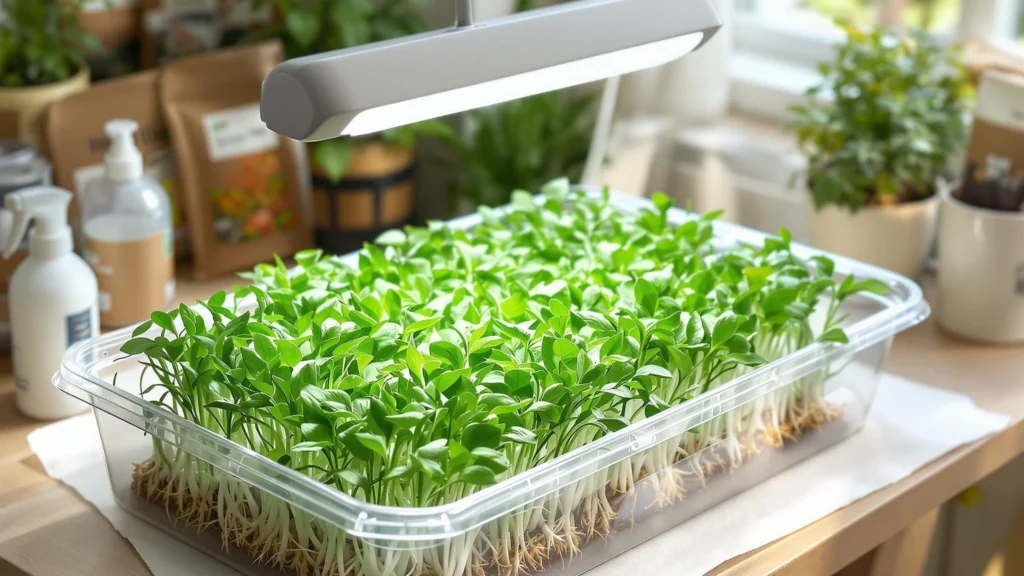Fresh, crunchy, and packed with nutrients, microgreens are turning into the go-to greens for home growers looking to get more from less. Growing them hydroponically means no dirt, no mess, and no garden required.
It is all about clean water, simple tools, and fast results right from your kitchen counter or windowsill. These tiny powerhouses grow in days and deliver bold flavors that make any dish feel gourmet.
With a small setup and the right light, anyone can grow trays of vibrant greens all year long. It is efficient, satisfying, and incredibly rewarding. There is no need to step outside to harvest a fresh batch of health and flavor 🌱💧🌿
Why Grow Microgreens Hydroponically?
Hydroponic cultivation of microgreens offers superior control over key growth factors like nutrients, pH, light, and moisture, resulting in faster growth, higher yields, and reduced disease risk. Nutrients are delivered directly to the roots via water, eliminating the inefficiencies and inconsistencies of soil.
These systems are highly space-efficient, enabling dense and vertical growing setups ideal for small urban areas. Unlike traditional farming, hydroponics allows for year-round cultivation, independent of climate or season. Additionally, hydroponics is remarkably water-efficient. Studies, including NASA research, show hydroponic systems can use up to 99 percent less water than soil-based methods, making them ideal for sustainable food production in drought-prone or urban regions.
Core Principles of Hydroponics
Hydroponics replaces soil with a nutrient-rich water solution that delivers essential elements directly to plant roots, accelerating growth by up to three times compared to soil. The solution must be balanced with macronutrients (NPK), secondary nutrients (like calcium and magnesium), and trace elements. Monitoring Electrical Conductivity (EC) and maintaining an optimal pH range of 5.5 to 6.5 ensures efficient nutrient uptake, especially for microgreens.
Oxygenation is critical for root respiration and nutrient absorption. This can be managed through air stones in Deep Water Culture systems, passive oxygenation in Kratky setups, or timed flooding in Ebb and Flow systems. Water temperature also plays a vital role, with the ideal range for microgreens between 18 to 25°C. Maintaining these core principles—nutrient balance, pH, oxygen, and temperature—creates a stable, productive environment for growing healthy, nutrient-dense microgreens.
Choosing the Right Hydroponic System for Microgreens
Selecting the appropriate hydroponic system for growing microgreens is crucial to success, especially for beginners. While many hydroponic techniques exist, not all are ideally suited for shallow-rooted crops like microgreens. Because these greens grow quickly and require minimal root depth, the system should offer stability, good water retention, and even nutrient distribution.
Kratky Method
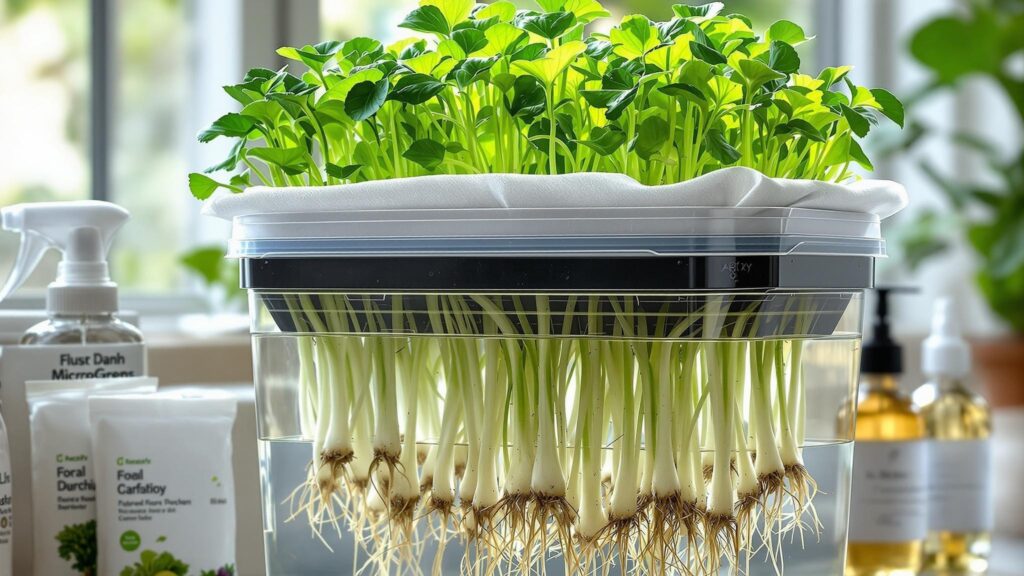
The Kratky method is a simple, passive hydroponic system perfect for growing microgreens, especially for beginners or those with limited resources. In this setup, plants are suspended above a nutrient reservoir with their roots partially submerged in the solution. As the plants consume the water, the nutrient level gradually drops, creating an air gap that supplies oxygen to the roots without needing pumps or aeration devices. This “set it and forget it” approach works well for microgreens because their short growth cycle usually prevents oxygen deprivation. The low-maintenance nature and minimal equipment make the Kratky method a popular choice for small-scale and home growers.
Deep Water Culture (DWC)
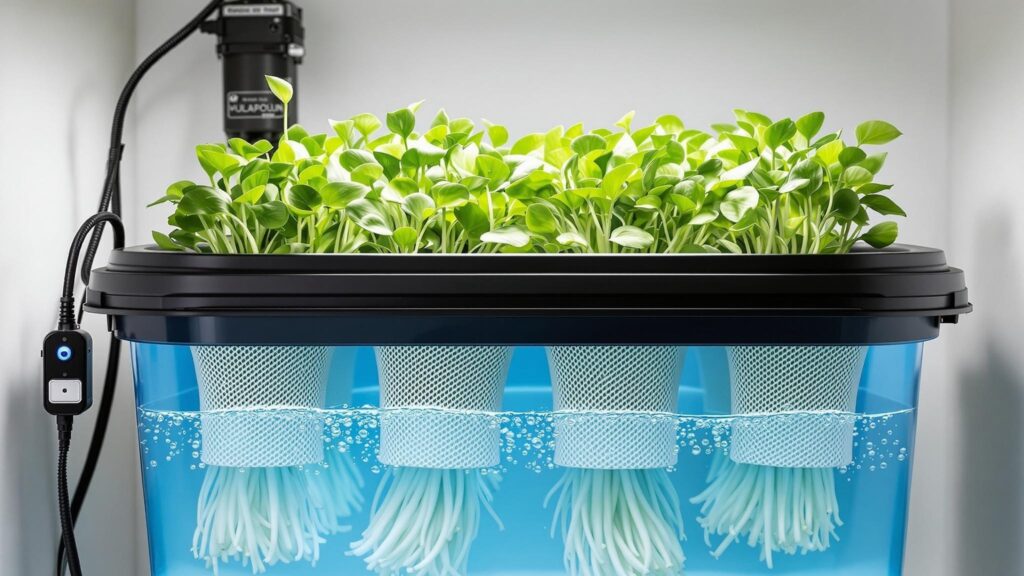
Deep Water Culture is a more active hydroponic system where microgreen roots are continuously submerged in a reservoir filled with nutrient-rich, oxygenated water. An air stone connected to an air pump bubbles oxygen into the water, preventing root rot and encouraging rapid, healthy growth. DWC offers a controlled environment that supports consistent nutrient delivery and oxygen availability, making it suitable for both hobbyists and commercial growers. Although it requires electricity and regular monitoring, the system’s ability to promote vigorous growth makes it a favorite for scaling microgreen production.
Ebb and Flow System
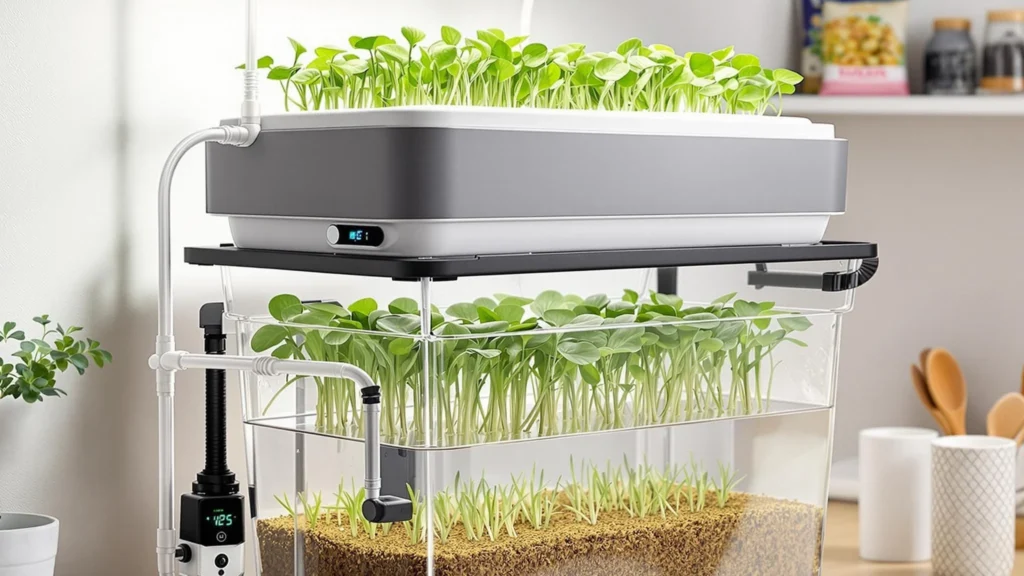
The Ebb and Flow system operates by periodically flooding a grow tray containing microgreens with nutrient solution, then draining it back into a reservoir. This cycle delivers nutrients and water efficiently while ensuring the roots have regular access to oxygen during the draining phase. The timed flooding creates an environment that balances hydration and aeration, which is critical for root health and nutrient uptake. While more complex than passive systems, Ebb and Flow allows for precise control of water cycles and is suitable for larger or commercial microgreen operations requiring higher output and automation.
Nutrient Film Technique (NFT)
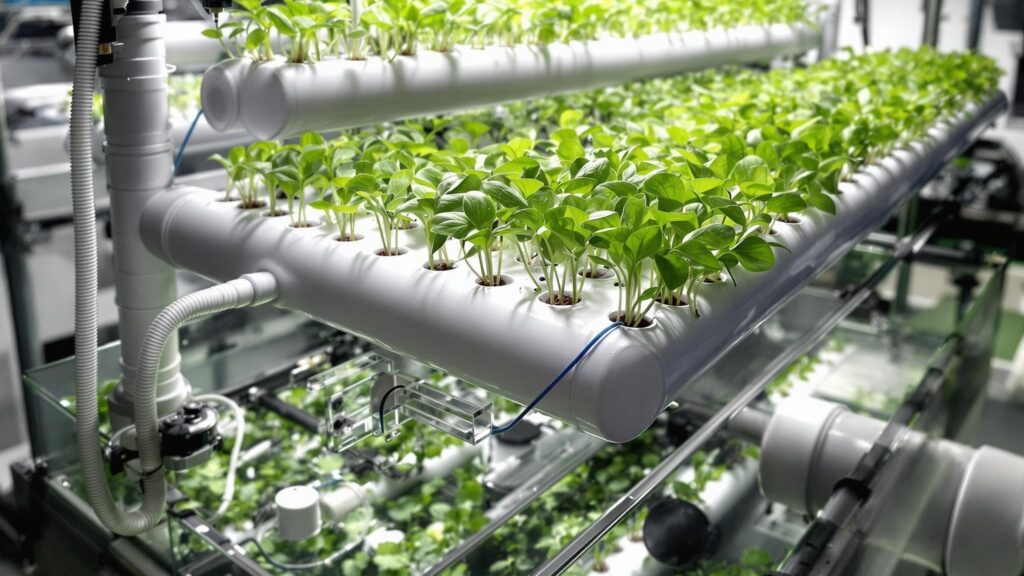
Nutrient Film Technique involves a continuous, thin flow of nutrient-rich water running over microgreen roots suspended in shallow channels or troughs. This method ensures roots receive a constant supply of oxygen and nutrients without being fully submerged, minimizing the risk of root rot. The water’s steady movement prevents stagnation, maintaining optimal conditions for root health. NFT is water- and nutrient-efficient and can be arranged vertically to maximize space, making it ideal for urban growers or commercial producers with limited areas. However, the system demands regular maintenance to avoid clogs or pump failures, as any disruption can quickly affect the plants due to the thin nutrient film.
Materials and Setup for a DIY Microgreens Hydroponic Garden
Setting up a hydroponic system for microgreens does not require expensive equipment or specialized construction. With a clear understanding of plant needs and a few accessible materials, anyone can create an efficient, compact hydroponic garden at home. The key components include a growing tray or container, a lightproof reservoir, a suitable growing medium, net pots or grow mats, a nutrient solution, and adequate lighting if natural sunlight is limited.
For the structure, many growers opt to use standard 10×20 nursery trays as the base. These trays are shallow but wide, making them ideal for growing a dense canopy of microgreens. If using the Kratky method, a second tray without holes can serve as a reservoir, while the top tray holds a growing mat or mesh that supports the seeds. A foam board or food-safe plastic sheet can also be used to suspend net pots over a nutrient reservoir in DWC setups. The depth of the nutrient solution should be around 1 to 2 inches for microgreens to ensure consistent moisture without risking stem rot.
Lighting plays a critical role in successful hydroponic microgreens production. Although some herbs and leafy greens can survive with minimal light, microgreens require at least 12 to 16 hours of strong illumination per day for optimal growth. If natural light is inadequate, full-spectrum LED grow lights that mimic sunlight are recommended. These lights should be positioned 6 to 12 inches above the canopy and adjusted as the plants grow to prevent legginess. Temperature and humidity should also be monitored. Most microgreens prefer a temperature between 18 and 24 degrees Celsius and relative humidity around 50 to 70 percent. Adequate airflow is important to prevent mold and maintain plant health. A small oscillating fan can improve air circulation and strengthen plant stems naturally.
Selecting Seeds for Hydroponic Microgreens
The selection of high-quality seeds is fundamental to the success of any microgreens setup. Unlike traditional gardening, where seeds may be selected for long-term yield or resistance to pests, microgreens require seeds that are fast-growing, clean, and untreated with fungicides or pesticides. Certified organic or non-GMO seeds are strongly recommended for hydroponic systems, particularly because the plants are consumed in their early stages and often raw, so safety and purity are paramount.
Different types of seeds offer varying flavors, colors, textures, and nutritional profiles. Popular choices include brassicas such as broccoli, kale, and mustard, which are known for their spicy and savory notes. Radish and arugula add a peppery punch, while sunflower and pea shoots deliver a mild, nutty flavor and crunchy texture. Red amaranth and beet microgreens are favored for their deep pigmentation and visual appeal, making them popular for culinary plating. Some seeds, like cilantro and basil, take slightly longer to germinate and grow but are still viable options for experienced growers.
When growing hydroponically, it is important to consider seed density. Microgreens are grown closely together to maximize yield in limited space. A typical rule is to use about 10 to 12 grams of seed per 10×20 tray, but this varies depending on the seed type and size. Larger seeds like peas and sunflowers require more space to avoid overcrowding, while smaller seeds like basil or arugula can be sown more densely. Before sowing, many growers soak seeds to improve germination rates. Soaking time varies by species but typically ranges from 4 to 12 hours. Proper sowing techniques and good hygiene, including sterilizing trays and equipment, reduce the risk of mold and disease.
Nutrient Requirements for Hydroponic Microgreens
Hydroponics offers precise control over nutrient delivery, ensuring optimal growth even in the short lifecycle of microgreens. Although their needs are simpler than mature plants, microgreens still require a balanced mix of nutrients for healthy development. The essential macronutrients are nitrogen for leafy growth, phosphorus for root development, and potassium for overall vigor. Calcium and magnesium are also important for cell structure and chlorophyll production. Many growers use all-in-one solutions like General Hydroponics Flora Series, often supplemented with CalMag for crops like spinach or cilantro.
Ideal conditions for most microgreens include an EC range of 1.0 to 1.8 and a pH between 5.5 and 6.5. EC reflects the concentration of nutrients in the solution, and pH influences nutrient availability. Monitoring both with digital meters helps prevent underfeeding, nutrient lockout, or toxicity. While some believe microgreens can grow with just water, controlled studies have shown up to 20 percent higher yields and better flavor when using optimized nutrient solutions.
Light and Temperature Requirements
Light and temperature are key to healthy, vigorous microgreens. They typically need 12 to 16 hours of full-spectrum light per day for optimal photosynthesis and pigmentation. LED grow lights are ideal due to their energy efficiency, low heat output, and ability to mimic natural sunlight. Lights should be placed 6 to 12 inches above the canopy and adjusted as plants grow to ensure even exposure without burning.
Temperature should remain between 18 and 24 degrees Celsius for consistent germination and growth. Below this range, growth slows, while temperatures above 26 degrees can lead to mold, premature bolting, or bitterness. Climate control tools like fans, heaters, or air conditioning may be necessary in extreme environments. When managed correctly, light and temperature play a crucial role in maximizing yield, flavor, and nutrient density.
Monitoring pH, EC, and Water Quality
Precision is one of the core strengths of hydroponic growing, and that includes constant monitoring of water parameters like pH, electrical conductivity (EC), and general water quality. These elements directly affect nutrient uptake, plant health, and final yield. Because microgreens have a short lifecycle, imbalances in these parameters can quickly stunt growth or cause crop failure if not corrected swiftly.
The ideal pH range for hydroponic microgreens is between 5.5 and 6.5. Within this range, nutrients remain soluble and accessible to plants. Deviations outside of this range can cause nutrient lockout, a condition where certain minerals are present in the solution but cannot be absorbed by the plant. For example, iron and manganese become unavailable at higher pH values, leading to chlorosis and reduced growth. To measure pH accurately, digital pH meters are recommended over strips or chemical tests due to their precision. Adjustments can be made using food-safe pH up and pH down solutions, commonly made with phosphoric acid or potassium hydroxide.
Electrical conductivity (EC) is another critical metric. It indicates the total concentration of dissolved salts in the nutrient solution. For microgreens, an EC of 1.0 to 1.8 is usually optimal. Lower values suggest underfeeding, while higher values may cause osmotic stress or nutrient toxicity. PPM, or parts per million, is a related unit that provides more granular data. Monitoring EC helps growers adjust fertilizer concentrations in real-time to suit specific plant needs. A digital EC meter allows for daily tracking and quick corrections.
Water quality also plays an essential role in hydroponics. Tap water may contain chlorine, chloramine, or high levels of dissolved solids that can interfere with nutrient absorption. Whenever possible, use filtered or distilled water with a known baseline EC of near zero. If using tap water, allow it to sit out for 24 hours to let chlorine evaporate, or treat it with dechlorinating agents. Regularly cleaning reservoirs, tubing, and trays prevents biofilm buildup and helps maintain a sanitary growing environment.
Common Challenges and How to Overcome Them
While hydroponic microgreens are relatively easy to grow, there are several common challenges that new growers often face. These issues, if not addressed quickly, can impact both the quality and quantity of harvests. Fortunately, most of these problems have straightforward solutions once the grower understands their root causes.
One of the most frequent problems is mold and fungal growth, particularly in dense trays with poor airflow. Since microgreens are grown closely together and thrive in humid environments, they create ideal conditions for mold to develop. This often appears as a white fuzzy layer near the roots or on the surface of the growing medium. To prevent this, ensure adequate ventilation using fans and avoid overwatering. Using hydrogen peroxide at safe concentrations during the sterilization process can also reduce microbial contamination. Moreover, maintaining a consistent temperature below 25 degrees Celsius will inhibit fungal spores from multiplying.
Another challenge is inconsistent germination or uneven growth. This can occur due to non-uniform seed distribution, irregular watering, or fluctuating temperatures. To ensure even growth, spread seeds evenly across the tray and press them gently into the grow mat to maintain contact. Covering the tray with a blackout dome for the first 2 to 4 days can promote uniform germination. Once seeds sprout, removing the cover and exposing them to light helps prevent legginess and encourages even canopy development.
Nutrient deficiencies are another concern, though less common in short-cycle microgreens. Still, yellowing leaves or slow growth can result from incorrect EC or pH levels, or from using low-quality fertilizer. Regularly monitoring the nutrient solution and adjusting as needed prevents most issues. If problems persist, performing a water flush and replacing the nutrient mix can reset the system.
A verified study from the University of Maryland found that about 65 percent of microgreen growers reported their primary issue during the first three months was fungal contamination due to high humidity and poor sanitation. This underscores the importance of environmental control and strict hygiene in hydroponic setups.
Harvesting, Storing, and Using Microgreens
Harvesting microgreens is a rewarding process that marks the culmination of a carefully managed growth cycle. Most varieties are ready to harvest within 7 to 14 days after germination, once they have developed their first set of true leaves. Timing the harvest is essential to ensure optimal flavor, color, and nutritional value. Harvesting too early may reduce yield, while harvesting too late can lead to fibrous textures or bitter flavors.
The best time to harvest is early in the morning when the plants are most hydrated and vibrant. Using clean, sharp scissors or a sterilized knife, cut the greens just above the growing medium. Avoid pulling the plants from the roots, as this can introduce debris and shorten shelf life. Immediately after harvest, gently rinse the microgreens in cold water to remove any dust or residue. Use a salad spinner or air dry them on paper towels to remove excess moisture before storage.
Proper storage is crucial to maintaining the freshness and nutritional content of microgreens. Once dried, place them in airtight containers or food-safe bags and store them in the refrigerator. Most microgreens stay fresh for up to seven days when stored at temperatures between 2 to 4 degrees Celsius. Adding a dry paper towel inside the container can help absorb any residual moisture and extend shelf life. Commercial growers may invest in vacuum-sealing machines or cold storage units for longer preservation.
Microgreens are incredibly versatile in the kitchen. They can be used in salads, sandwiches, smoothies, and even soups. Their vibrant colors and intense flavors make them popular garnishes in fine dining establishments. Beyond aesthetics, microgreens are nutritional powerhouses. Studies have shown that red cabbage microgreens, for example, contain up to 40 times more vitamin E and six times more vitamin C than their mature counterparts. Incorporating these greens into daily meals provides a dense source of nutrients with minimal calorie intake.
Nutritional Benefits of Hydroponic Microgreens
Hydroponically grown microgreens are not only a sustainable solution for urban agriculture but also a concentrated source of essential nutrients. Due to their early harvest stage, microgreens typically contain higher levels of vitamins, minerals, and antioxidants compared to their mature counterparts. This makes them a powerful supplement to modern diets, especially in urban settings where access to fresh produce may be limited.
Multiple scientific studies have validated these claims. For instance, a USDA-funded study conducted by the University of Maryland found that red cabbage microgreens contained 40 times more vitamin E and six times more vitamin C than mature cabbage. Similarly, cilantro microgreens showed exceptionally high levels of lutein and beta-carotene, both of which support vision and skin health. These elevated nutrient levels are due to the rapid growth phase of microgreens, during which plant cells are actively dividing and accumulating compounds necessary for full development.
From a hydroponic perspective, controlling the nutrient solution gives growers the ability to customize nutrient profiles and optimize for specific outcomes. This means you can tailor the nutrient mix to promote higher concentrations of specific vitamins or minerals. For example, increasing the magnesium content in the solution can boost chlorophyll production, leading to deeper green pigmentation and higher antioxidant capacity. Additionally, hydroponics ensures the plants are not exposed to soil contaminants, reducing the risk of heavy metal accumulation or pathogen exposure. This controlled environment results in cleaner, safer, and more nutritionally consistent produce.
Economic Potential: Side Hustle or Full-Time Business
The economic potential of growing hydroponic microgreens is substantial, making it an appealing opportunity for both hobbyists and serious entrepreneurs. Microgreens have a high market value due to their culinary appeal, nutritional density, and relatively short growth cycle. Most varieties mature in just one to three weeks, enabling growers to harvest multiple batches per month and scale production based on market demand.
Starting a small-scale operation can be done with minimal investment. A simple home setup using a vertical rack, grow lights, trays, and a nutrient reservoir can cost less than \$300 and still yield a few pounds of microgreens per week. At retail prices ranging between \$25 to \$40 per pound, even part-time growers can generate a modest income from local farmers’ markets, restaurants, or direct-to-consumer subscriptions. For those looking to scale, commercial setups in controlled environment agriculture (CEA) facilities or shipping containers can produce hundreds of pounds monthly. These systems may require higher upfront costs but offer automation, increased yields, and year-round production.
Profitability also hinges on your ability to manage inputs efficiently. Since hydroponic systems recycle water and use space effectively, operational costs tend to be lower than traditional farming. Moreover, hydroponic microgreens have a premium brand image associated with sustainability and freshness. This allows growers to command better prices and market themselves directly to health-conscious consumers or high-end culinary businesses. Platforms like Instagram and local community-supported agriculture (CSA) programs offer effective channels for marketing without major overheads. As food security becomes a growing concern globally, microgreens offer a high-value, low-footprint business opportunity with compelling economics.
Sustainability and Environmental Impact
Hydroponically grown microgreens offer significant environmental advantages over traditional soil-based agriculture. First, hydroponics uses substantially less water. Studies by NASA and agricultural research institutions have shown that hydroponic systems can reduce water usage by up to 90 to 95 percent compared to soil farming. This is particularly important in regions facing water scarcity or where agriculture must be practiced indoors due to urban constraints or soil contamination.
The closed-loop nature of hydroponic systems allows for water and nutrient recycling, which minimizes runoff and pollution. Traditional farming often leads to nutrient leaching into surrounding ecosystems, contributing to eutrophication and biodiversity loss. In hydroponic setups, every drop of water is accounted for, and nutrients are delivered in precise quantities to support optimal plant growth. This precision reduces waste and environmental degradation.
In terms of land use, microgreens require minimal space. A small corner of an apartment or a vertical rack in a greenhouse can produce substantial yields. This efficiency makes hydroponic systems ideal for urban environments where land is both limited and expensive. Additionally, because hydroponic microgreens can be grown without pesticides or herbicides, the ecological impact of chemical use is eliminated. This not only benefits the grower and consumer but also reduces airborne or soil-borne contamination. As the world faces increasing pressure to adopt sustainable farming practices, hydroponics stands out as a viable, future-forward solution that aligns with both ecological and economic sustainability goals.
🌿 Recommended Microgreens Supplies |
Final Remarks
Growing microgreens hydroponically offers a sustainable, efficient, and space-saving way to produce nutrient-rich greens year-round. By choosing the right system and carefully managing nutrients, light, and oxygen, growers can enjoy faster growth and higher yields without soil, making hydroponics a smart choice for both beginners and commercial producers.
